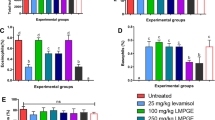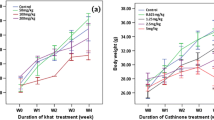Abstract
Drug development can depend on natural products. The Euphorbiaceae family, especially the genus Euphorbia, with a distinct regard to the Euphorbia tirucalli, is used as folk medicine in some Saudi Arabian regions. There is a lot of evidence that its latex has immunomodulatory activities. It is possible that the mechanism for such activities involves immune cells activation and production of cytokines. For the first time, in this work we aim to evaluate the production of \(\hbox {T}_{\mathrm{H}}1\) cytokines (IFN-\(\upgamma \), TNF-\(\upalpha \), GM-CSF and IL-2), \(\hbox {T}_{\mathrm{H}}2\) cytokines (IL-4, IL-6, IL-10 and IL-13) and chemokines (IL-\(1\upalpha \), IL-\(1\upbeta \), IL-12 and RANTES) in vivo by treating rats with ethanol extract of E. tirucalli latex gathered from Abha, Aseer, KSA. Adult male Sprague Dawley rats were divided into three groups: group 1 received no treatment, while groups 2 and 3 orally received 0.250 mg latex extract in 0.5 ml daily for 21 or 35 days, respectively. At the end of the experiment, blood was taken and tested for the concentrations of \(\hbox {T}_{\mathrm{H}}1\) and \(\hbox {T}_{\mathrm{H}}2\) cytokines and chemokines. The main compound of the purified extract was euphol. The extract presented a potential to induce significant increases in IL-\(1\upbeta \), IL-2, IL-6, GM-CSF and RANTES. In conclusion, ethanol extract contained mainly the euphol. The extract made some immunological stimulation that appeared in \(\hbox {T}_{\mathrm{H}}1\) and \(\hbox {T}_{\mathrm{H}}2\) cytokines and chemokines profiles changes. These changes are in favor of enhancing and enforcing the immune system. This extract can be recommended as a supplementary material for immunological drugs such as vaccines.
Similar content being viewed by others
References
Webster, G.L.: Classification of the Euphorbiaceae. Mo. Bot. Gard. 81, 3–32 (1994)
Seigler, D.S.: Phytochemistry and systematics of the Euphorbiaceae. Ann. Mo. Bot. Gard. 81, 380 (1994). https://doi.org/10.2307/2992104
Rizk, A.-F.M.: The chemical constituents and economic plants of the Euphorbiaceae. Bot. J. Linn. Soc. 94, 293–326 (1987). https://doi.org/10.1111/j.1095-8339.1987.tb01052.x
Schuhly, W.: Major herbs of ayurveda (2004)
Lai, X.Z.; Yang, Y.B.; Shan, X.L.: The investigation of Euphorbiaceous medicinal plants in Southern China. Econ. Bot. 58, S307–S320 (2004). https://doi.org/10.1663/0013-0001(2004)58[s307:tioemp]2.0.co;2
Shlamovitz, G.Z.; Gupta, M.; Diaz, J.A.: A case of acute keratoconjunctivitis from exposure to latex of Euphorbia tirucalli (pencil cactus). J. Emerg. Med. 36, 239–241 (2009). https://doi.org/10.1016/j.jemermed.2007.03.034
Gupta, B.; Srivastava, S.R.; Goyal, R.: Therapeutic uses of Euphorbia thymifolia: a review. Pharmacogn. Rev. 1, 299–304 (2007)
Appendino, G.; Szallasi, A.: Euphorbium: modern research on its active principle, resiniferatoxin, revives an ancient medicine. Life Sci. 60, 681–696 (1997). https://doi.org/10.1016/s0024-3205(96)00567-x
Elujoba, A.A.; Odeleye, O.M.; Ogunyemi, C.M.: Traditional medicine development for medical and dental primary health care delivery system in Africa. Afr. J. Tradit. Complement. Altern. Med. 2, 46–61 (2004). https://doi.org/10.4314/ajtcam.v2i1.31103
Ekpo, O.E.; Pretorius, E.: Asthma, Euphorbia hirta and its anti-inflammatory properties (2007)
Kiem, P.Van; Thu, V.K.; Yen, P.H.; Nhiem, N.X.; Tung, N.H.; Cuong, N.X.; Minh, C.Van; Huong, H.T.; Hyun, J.-H.; Kang, H.-K.; Kim, Y.H.: New triterpenoid saponins from Glochidion eriocarpum and their cytotoxic activity. Chem. Pharm. Bull. (Tokyo) 57, 102–105 (2009). https://doi.org/10.1248/cpb.57.102
Mathabe, M.C.; Hussein, A.A.; Nikolova, R.V.; Basson, A.E.; Meyer, J.J.M.; Lall, N.: Antibacterial activities and cytotoxicity of terpenoids isolated from Spirostachys africana. J. Ethnopharmacol. 116, 194–197 (2008). https://doi.org/10.1016/j.jep.2007.11.017
Gupta, N.; Vishnoi, G.; Wal, A.; Wal, P.: Medicinal value of Euphorbia tirucalli. Syst. Rev. Pharm. 4, 40 (2013). https://doi.org/10.4103/0975-8453.135843
Kumar, A.; Prasad, M.R.; Mishra, D.; Srivastav, S.K.; Srivastav, A.K.: Toxicity of aqueous extract of Euphorbia tirucalli latex on catfish, Heteropneustes fossilis. Ecotoxicol. Environ. Saf. 73, 1671–1673 (2010). https://doi.org/10.1016/j.ecoenv.2010.08.003
Brasileiro, B.G.; Pizziolo, V.R.; Raslan, D.S.; Jamal, C.M.; Silveira, D.: Antimicrobial and cytotoxic activities screening of some Brazilian medicinal plants used in Governador Valadares district. Rev. Bras. Ciências Farm. 42, 195–202 (2006). https://doi.org/10.1590/s1516-93322006000200004
Parekh, J.; Chanda, S.: Antibacterial and phytochemical studies on twelve species of Indian medicinal plants. Afr. J. Biomed. Res. (2010). https://doi.org/10.4314/ajbr.v10i2.50624
Lin, S.-J.; Yeh, C.-H.; Yang, L.-M.; Liu, P.-C.; Hsu, F.-L.: Phenolic compounds from Formosan Euphorbia tirucalli. J. Chin. Chem. Soc. 48, 105–108 (2001). https://doi.org/10.1002/jccs.200100019
Uchida, H.; Sugiyama, R.; Nakayachi, O.; Takemura, M.; Ohyama, K.: Expression of the gene for sterol-biosynthesis enzyme squalene epoxidase in parenchyma cells of the oil plant, Euphorbia tirucalli. Planta 226, 1109–1115 (2007). https://doi.org/10.1007/s00425-007-0557-4
Valadares, M.C.; Carrucha, S.G.; Accorsi, W.; Queiroz, M.L.S.: Euphorbia tirucalli L. modulates myelopoiesis and enhances the resistance of tumour-bearing mice. Int. Immunopharmacol. 6, 294–299 (2006). https://doi.org/10.1016/j.intimp.2005.07.013
Kuster, R.M.; Caxito, M.L.C.; Sabino, K.C.C.; da Costa, H.B.; Tose, L.V.; Romão, W.; Vaz, B.G.; Silva, A.G.: Identification of maloyl glucans from Euphorbia tirucalli by ESI-(–)-FT-ICR MS analyses. Phytochem. Lett. 12, 209–214 (2015). https://doi.org/10.1016/j.phytol.2015.04.008
Cataluña, P.; Rates, S.M.K.: The traditional use of the latex from Euphorbia tirucalli Linnaeus (Euphorbiaceae) in the treatment of cancer in South Brazil. Acta Hortic. 501, 289–296 (1999). https://doi.org/10.17660/actahortic.1999.501.46
Furstenberber, G.; Hecker, E.: On the active principles of the spurge family (Euphorbiaceae): XI. The irritant and tumor promoting diterpene esters of Euphorbia tirucalli L. originating from South Africa. Z. Naturforsch. 40, 631–646 (1985)
Sadeghi-Aliabadi, H.; Sajjadi, S.E.; Khodamoradi, M.: Cytotoxicity of Euphorbia macroclada on MDA-MB-468 breast cancer cell line. Iran. J. Pharm. Sci. 5, 103–108 (2009)
Zhang, L.; Gao, L.; Li, Z.; Yan, X.; Yang, Y.; Tang, Y.; Cao, Y.; Ding, A.: Bio-guided isolation of the cytotoxic terpenoids from the roots of Euphorbia kansui against human normal cell lines L-O2 and GES-1. Int. J. Mol. Sci. 13, 11247–11259 (2012). https://doi.org/10.3390/ijms130911247
Mwine, J.; Van Damme, P.; Hastilestari, B.R.; Papenbrock, J.: Euphorbia tirucalli L. (Euphorbiaceae)—the miracle tree: current status of knowledge. https://doi.org/10.1021/bk-2013-1127.ch001 (2013)
Baniadam, S.; Rahiminejad, M.R.; Ghannadian, M.; Saeidi, H.; Ayatollahi, A.M.; Aghaei, M.: Cycloartane triterpenoids from Euphorbia macrostegia with their cytotoxicity against MDA-MB48 and MCF-7 cancer cell lines. Iran. J. Pharm. Res. 13, 135–141 (2014)
Duarte, N.; Ramalhete, C.; Varga, A.; Molnar, J.; Ferreira, M.J.: Multidrug resistance modulation and apoptosis induction of cancer cells by terpenic compounds isolated from Euphorbia species. Anticancer Res. 29, 4467–4472 (2009)
Hsieh, W.-T.; Lin, H.-Y.; Chen, J.-H.; Kuo, Y.-H.; Fan, M.-J.; Wu, R.S.-C.; Wu, K.-C.; Wood, W.G.; Chung, J.-G.: Latex of Euphorbia antiquorum induces apoptosis in human cervical cancer cells via c-jun N-terminal kinase activation and reactive oxygen species production. Nutr. Cancer 63, 1339–1347 (2012)
Alakurtti, S.; Mäkelä, T.; Koskimies, S.; Yli-Kauhaluoma, J.: Pharmacological properties of the ubiquitous natural product betulin. Eur. J. Pharm. Sci. 29, 1–13 (2006)
Kasperczyk, H.; La Ferla-Brühl, K.; Westhoff, M.A.; Behrend, L.; Zwacka, R.M.; Debatin, K.-M.; Fulda, S.: Betulinic acid as new activator of NF-\(\upkappa \)B: molecular mechanisms and implications for cancer therapy. Oncogene 24, 6945–6956 (2005)
Akihisa, T.; Tokuda, H.; Ichiishi, E.; Mukainaka, T.; Toriumi, M.; Ukiya, M.; Yasukawa, K.; Nishino, H.: Anti-tumor promoting effects of multiflorane-type triterpenoids and cytotoxic activity of karounidiol against human cancer cell lines. Cancer Lett. 173, 9–14 (2001). https://doi.org/10.1016/s0304-3835(01)00689-9
Dutra, R.C.; de Cezaro de Souza, P.R.; Bento, A.F.; Marcon, R.; Bicca, M.A.; Pianowski, L.F.; Calixto, J.B.: Euphol prevents experimental autoimmune encephalomyelitis in mice: evidence for the underlying mechanisms. Biochem. Pharmacol. 83, 531–542 (2012). https://doi.org/10.1016/j.bcp.2011.11.026
Passos, G.F.; Medeiros, R.; Marcon, R.; Nascimento, A.F.Z.; Calixto, J.B.; Pianowski, L.F.: The role of PKC/ERK1/2 signaling in the anti-inflammatory effect of tetracyclic triterpene euphol on TPA-induced skin inflammation in mice. Eur. J. Pharmacol. 698, 413–420 (2013). https://doi.org/10.1016/j.ejphar.2012.10.019
Abbas, A.K.; Lichtman, A.; Pillai, S.: Cellular and Molecular Immunology. Elsevier, Amsterdam (2014)
Vianna, H.R.; Soares, C.M.B.M.; Tavares, M.S.; Teixeira, M.M.; Silva, A.C.S.: e: Inflammation in chronic kidney disease: the role of cytokines. J. Bras. Nefrol. 33, 351–364 (2011)
Nedoszytko, B.; Sokołowska-Wojdyło, M.; Ruckemann-Dziurdzińska, K.; Roszkiewicz, J.; Nowicki, R.J.: Chemokines and cytokines network in the pathogenesis of the inflammatory skin diseases: atopic dermatitis, psoriasis and skin mastocytosis. Adv. Dermatol. Allergol. 31, 84–91 (2014)
Kaufmann, S.H.: Lymphokines, interleukins, cytokines: function and action. Immun. Infekt. 15, 127–134 (1987)
Mosmann, T.R.; Coffman, R.L.: THI and TH2 cells: different patterns of lymphokine secretion lead to different functional properties. Ann. Rev. Immunol. 7, 145–73 (1989)
Borish, L.C.; Steinke, J.W.: 2. Cytokines and chemokines. J. Allergy Clin. Immunol. 111, S460–S475 (2003). https://doi.org/10.1067/mai.2003.108
Khatami, M.; Pourseyedi, S.; Khatami, M.; Hamidi, H.; Zaeifi, M.; Soltani, L.: Synthesis of silver nanoparticles using seed exudates of Sinapis arvensis as a novel bioresource, and evaluation of their antifungal activity. Bioresour. Bioprocess. 2, 19 (2015). https://doi.org/10.1186/s40643-015-0043-y
Chen, C.L.; Chen, Y.P.; Lin, M.W.; Huang, Y.B.; Chang, F.R.; Duh, T.H.; Wu, D.C.; Wu, W.C.; Kao, Y.C.; Yang, P.H.: Euphol from Euphorbia tirucalli negatively modulates TGF-\(\upbeta \) responsiveness via TGF-\(\upbeta \) receptor segregation inside membrane rafts. PLoS ONE 10, e0140249 (2015). https://doi.org/10.1371/journal.pone.0140249
Munhoz, A.C.M.; Minozzo, B.R.; Cruz, L.S.; Oliveira, T.L.; Machado, W.M.; Pereira, A.V.; Fernandes, D.; Manente, F.A.; Vellosa, J.C.R.; Nepel, A.; Barison, A.; Beltrame, F.L.: Chemical and pharmacological investigation of the stem bark of Synadenium grantii. Planta Med. 80, 458–464 (2014). https://doi.org/10.1055/s-0034-1368300
Amirghofran, Z.; Azadmehr, A.; Bahmani, M.; Javidnia, K.: Stimulatory effects of Euphorbia cheiradenia on cell mediated immunity and humoral antibody synthesis. Iran. J. Immunol. 5, 115–123 (2008)
Singh, N.; Husain, S.; Limaye, A.P.; Pursell, K.; Klintmalm, G.B.; Pruett, T.L.; Somani, J.; Stosor, V.; del Busto, R.; Wagener, M.M.; Steele, C.: Systemic and cerebrospinal fluid T-helper cytokine responses in organ transplant recipients with Cryptococcus neoformans infection. Transpl. Immunol. 16, 69–72 (2006). https://doi.org/10.1016/j.trim.2006.03.009
Betancur-Galvis, L.; Morales, G.; Forero, J.; Roldan, J.: Cytotoxic and antiviral activities of Colombian medicinal plant extracts of the Euphorbia genus. Mem. Inst. Oswaldo Cruz Rio Janeiro 97, 541–546 (2002). https://doi.org/10.1590/S0074-02762002000400017
Rahuman, A.A.; Gopalakrishnan, G.; Venkatesan, P.; Geetha, K.: Larvicidal activity of some Euphorbiaceae plant extracts against Aedes aegypti and Culex quinquefasciatus (Diptera: Culicidae). Parasitol. Res. 102, 867–873 (2008). https://doi.org/10.1007/s00436-007-0839-6
Arend, W.P.; Palmer, G.; Gabay, C.: \(\{\text{ IL }\}-1\), \(\{\text{ IL }\}-18\), and \(\{\text{ IL }\}-33\) families of cytokines. Immunol. Rev. 223, 20–38 (2008). https://doi.org/10.1111/j.1600-065x.2008.00624.x
Dinarello, C.A.: Immunological and inflammatory functions of the interleukin-1 family. Annu. Rev. Immunol. 27, 519–550 (2009). https://doi.org/10.1146/annurev.immunol.021908.132612
Jücker, M.; Abts, H.; Li, W.; Schindler, R.; Merz, H.; Günther, A.; von Kalle, C.; Schaadt, M.; Diamantstein, T.; Feller, A.C.: Expression of interleukin-6 and interleukin-6 receptor in Hodgkin’s disease. Blood 77, 2413–8 (1991)
Del Prete, G.; De Carli, M.; Almerigogna, F.; Giudizi, M.G.; Biagiotti, R.; Romagnani, S.: Human IL-10 is produced by both type 1 helper (Th1) and type 2 helper (Th2) T cell clones and inhibits their antigen-specific proliferation and cytokine production. J. Immunol. 150, 353–360 (1993)
Author information
Authors and Affiliations
Corresponding author
Rights and permissions
About this article
Cite this article
Ibrahim, E.H., Shaker, K.H., Kilany, M. et al. Cytokines/Chemokines Profile in Rats Treated with Euphorbia tirucalli Extract. Arab J Sci Eng 43, 3443–3451 (2018). https://doi.org/10.1007/s13369-018-3119-0
Received:
Accepted:
Published:
Issue Date:
DOI: https://doi.org/10.1007/s13369-018-3119-0




